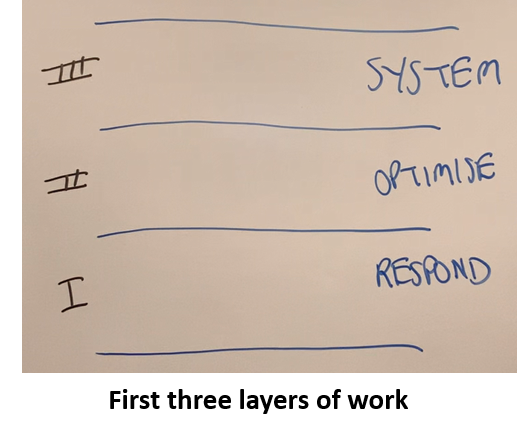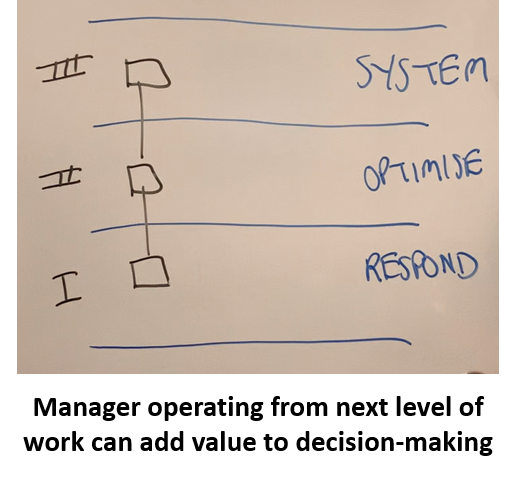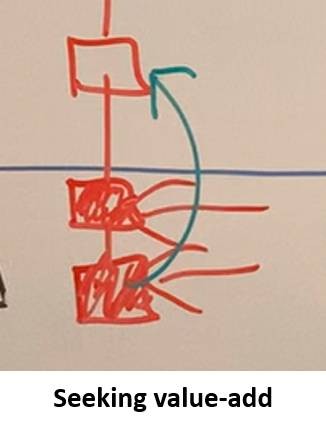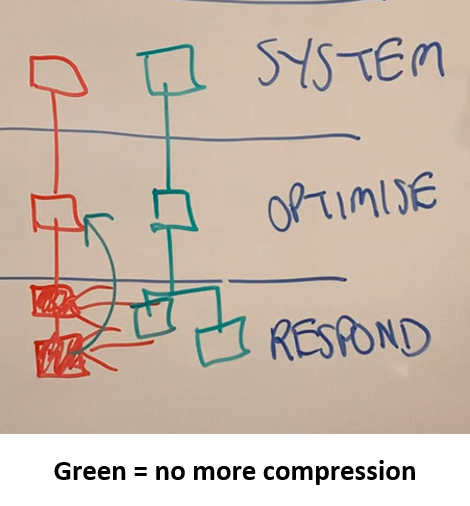Compression! Fix a major source of pain in your organisation
Want to watch this on video rather than read? Just click here. 5 mins, with captions.
Today’s article goes through one of the most common causes of organisational pain. A sore back is guaranteed to make people grumpy, and compression is a great way to give your organisation some proper spinal issues.
Now, a big proviso. Organisational hierarchies are very out of fashion right now. Here’s three things though:
- You’re in one, changing them is hard, and you might as well make the obvious changes to make the thing work properly
- There are many, many situations where a well-run managerial hierarchy is very much the most appropriate organisational design
- Hierarchies get a bad rap because of the exact sort of issue I am going to go through in this article. Fix these, and….hierarchies might just work fine!
OK, let’s get on with it.
Levels of Work
These ideas come from a brilliant theorist, researcher, consultant, and psychoanalyst (!) Dr. Elliott Jaques.

Jaques identified that work, (which I define as decision + action over time) occurs in identifiable layers of complexity. He gave them the decidedly unfashionable names of Stratum-I, Stratum-II etc. right up to Stratum VII (with an eighth maybe emerging now). I go for my own names to describe what’s going in each level, the first three I call Respond, Optimise and System.
We can draw it like this:

The first three work layers go like this (these are a very short overview):
Respond – respond to the situation in front of you, follow the guidelines, follow the procedures, look at what’s occurring, and make sure you get the thing done. Think, sell a T-shirt, copy and paste code, work on a difficult to fix engine, police officer collecting evidence
Optimise – diagnose what is happening to make changes to how things work. This is about taking a big step back to ask ‘what’s really going on here, why aren’t things working the way they were set up to?’ Think frontline manager, specialists, detective piecing the case together
System – put people, equipment, processes, technology, suppliers, the work of support areas all together to make a complete system that can consistently deliver for who it exists for. Think senior managers, senior specialist staff, those accountable for teams of teams.
The thing is, these three layers are what produce all the stuff and services of the world! When we go to the later levels, we are now talking about the purpose of what is produced and conceptually integrating the various systems, which takes us into the grey area of what people value. What do we start, stop and keep investing in. It’s still work, but it’s a different nature.
Value-Adding Leadership
One of the key findings of Elliott Jaques was that (in a managerial hierarchy) when people feel that they are getting ‘value-adding leadership’ from their manager, we find that their manager is operating from the next layer of work. (Note, a necessary condition, but not sufficient on its own).
By value-adding leadership, we mean the sort of leadership that provides context, direction, the right amount of challenge, valuable and appreciated feedback, and overall usefulness.
Putting it onto our diagram from before, it looks like this:

Compression
Unfortunately, this is not always the case. This is what ‘compression’ looks like:

While my diagram above shows compression occurring in the ‘Respond’ level of work; it can occur at any level. (And…there is a certain nuance regarding ‘Supervisory’ roles, but that’s for another time).
The red chart shows four roles in a reporting relationship, where there are only three natural levels of work. The lower coloured in role is being ‘compressed’ by their manager….and it’s not that manager’s fault as they didn’t design this structure!
This situation occurs very naturally – in this case the manager in the Optimise level got busy, possibly dealing with many direct reports, so put in a manager to take care of a lot of this work. What this did, however, was force in a level of work that doesn’t exist. Compression!
What are the chances you’ve got compression in your organisation? Research by Canadian consultant Ron Capelle of 59,000 managerial relationships across 76 organisations has found compression to exist in 36% of managerial relationships. That’s a lot of lost productivity. And pain.
Compression can sometimes be obvious on paper. With training and experience, analysis can quickly reveal the number of natural layers an organisation needs. One look at the org chart to count the number of reporting lines will immediately show whether compression is existing somewhere.
What Compression Looks Like
The effects of compression are very apparent, and consistent. The direct report feels micromanaged, often seeing their manager as having that as a personality trait. When receiving tasks from their manager, they may feel they don’t have enough context or meaning, or perhaps the overall plans don’t make enough sense. And there’s a sense of annoyance that the person gets to decide whether their performance is up to standard.

The same pain on the other side of the coin is felt by the manager. They might wish their team member just got on with the work. Would feel the questioning is incessant and would like them to stop disagreeing so often with the plans.
Of course, the two can sometimes get along fine…but we’ll still have a situation of lost human potential and/or unnecessary work. This is an example of ‘waste’ in the structure….Lean anyone?
(Working with these concepts for a decade, I can sometimes surprise people with what looks like some sort of clairvoyant knowledge of what’s happening in their organisation just by looking at an org chart….when what I’m talking about is the exact opposite of clairvoyance – it’s a heavily researched and proven body of knowledge that explains natural human behaviour. Once they see this…it’s not quite as impressive 😊)
The ‘Real’ Boss
Further to this, Elliott Jaques also discovered that people, when seeking additional context, meaning and assistance with their own decision-making, naturally go to the first person they can find in their managerial hierarchy that is operating from the next layer of work.
A diagram helps:

The green arrow shows how a person will ‘go around’ their own manger to find what they need so their work can have more meaning and be successful. Which causes frustration somewhere – the manager feels they are not able to do their job and usurped, the two-up manager in the next layer of work may wonder why the person isn’t taking their issue to their actual manager, because, after all, that’s why I created that job!
What we’ve done here is set up a situation where the system or the structure itself is a key source of pain for the people in it. Which means customers will eventually feel the pain too. As will the financials.
The Fix is Simple!
Here’s the fix:

The green shows the same roles, with the only change being the reporting relationship of the person who was in compression so they now have a manager who can add value from the next layer. If the person they were previously reporting to in the red structure was ‘showing them the ropes’ or providing other such expertise…that can still happen. But the person who now ultimately sets their work and it’s context can now do so with greater perspective.
The fix is this simple, which can be shocking. So why doesn’t it happen more often? Because we know it will be a temporary bummer for someone, which produces anxiousness….and us humans are great at avoiding anxiousness, even if we’re paid to step into it. And it does require some focussed thinking about what work is required at what levels…. which can always be put off until tomorrow.
It’s worth it though. The energy that is released when people are no longer compressed is huge. Often, it’s been so long that they’re not aware that it even exists.
Less pain for your people, freed up capability which leads to more productivity, which leads to happier customers and happier you when you look at your numbers come end of year.
Worth a look.
That’s all for this week. Thank you for reading. If you’d like 30 minutes of my time to talk through whether compression might be lurking in your organisation, just Reply to this email.
.
